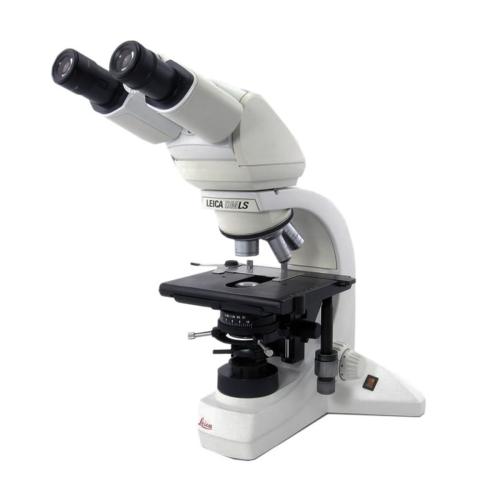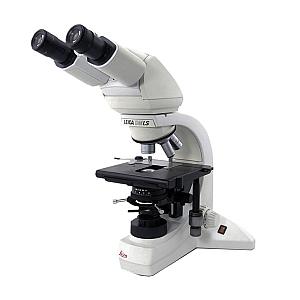The Leica DMLS is a high-precision optical microscope designed for routine and teaching applications in the laboratory. Thanks to its modular design, it offers great flexibility of use and exceptional image quality. It incorporates state-of-the-art optical components, homogeneous illumination and accessories compatible with various observation techniques such as phase contrast, dark field, polarisation and fluorescence. Robust, ergonomic and easy to maintain, the DMLS is a reliable tool for demanding professionals.
DMLS Microscope - Good Condition


Offer Details
Options :
leica DMLS microscope with 3 plan apochromat + 1x fluotar objective
Description
Leica DMLS microscope - Modular and ergonomic design for versatile use
The Leica DMLS belongs to the DML series of modular microscopes, allowing extensive customisation according to specific user requirements. It consists of a robust base with integrated transmitted light illumination, a stand with vibration-damping feet, an optical tube that can be adapted directly or via intermediate systems, and a set of interchangeable optical components. This modularity allows the DMLS to be used in a variety of configurations, ranging from classic transmitted light observation to more advanced techniques such as fluorescence or polarisation.
Ergonomics is at the heart of its design: the workstation must be stable, at the correct height (70–80 cm), and equipped with an adjustable seat to ensure fatigue-free observation. The microscope can be fitted with ergonomic modules to adjust the height of the viewing port and tilting tubes for optimum comfort.
Optical performance and precision illumination
The DMLS uses Leica infinity (∞) tube length objectives with M25 threading, compatible with 200 mm focal length optical tubes. It accepts C PLAN achromatic, N PLAN planachromatic, HC PL FLUOTAR semi-apochromatic and HC PL APO apochromatic objectives. Transmitted light illumination is provided by a 12 V/30 W halogen lamp integrated into the base, with intensity adjustment via a graduated knob.
Köhler illumination is facilitated by an adjustable field diaphragm and aperture diaphragm, ensuring a contrasted and homogeneous image. The microscope can also be equipped with immersion condensers (oil or water) to improve resolution with high numerical aperture objectives.
3. Compatibility with observation techniques
The DMLS supports several imaging techniques:
- Phase contrast: thanks to PH objectives and centred light rings in the condenser.
- Dark field: with objectives with an aperture ≤ 0.75 and suitable condenser discs.
- Polarisation: via the addition of an analyser and a polariser, as well as condenser lenses without mechanical constraints.
- Fluorescence: with filter cubes, discharge lamps (Hg, Xe) and specific illumination modules.
It is also compatible with TV microscopy and photomicrography, thanks to trinocular tubes and adapters for C-mount or B-mount cameras. Linear measurement and thickness measurement devices are available for quantitative applications.
Features
- Modular design for customised configurations
- Compatibility with multiple observation techniques (BF, PH, DF, POL, FLUO)
- Köhler illumination system with precise centring
- Tiltable optical tubes and ergonomic modules
- High-performance objectives with chromatic correction
- Adjustable diaphragms for contrast and depth of field
- Compatibility with photomicrography and TV microscopy
- Light ring centring system for phase contrast
- Accessories for linear and thickness measurement
- Easy maintenance and mechanical robustness
Technical Details
- Power supply voltage: 230/115/100 V ±10%
- Frequency: 50–60 Hz
- Power consumption: max. 40 W
- Operating temperature: 10–36 °C
- Relative humidity: 0–80% up to 30 °C
- Overvoltage category: II
- Contamination class: 2
- Lenses: M25, infinite tube (∞), compatible with f = 200 mm
- Diaphragms: adjustable field and aperture
- Lighting: integrated 12 V/30 W halogen lamp
- Field dimensions: depends on the eyepiece's field of view (10x/20, 10x/25, etc.)
Compatible Accessories
- Leica C PLAN, N PLAN, HC PL FLUOTAR, HC PL APO objectives
- HC PLAN eyepieces (10x/20, 10x/25, 12.5x/16, etc.)
- CL/PH, CLP/PH, UCL, UCLP condenser lenses (with or without immersion)
- Condenser discs with PH, DF light rings, POL compensators
- Polarisation analyser and polariser
- Filter cubes for fluorescence
- Lamp housings for Hg and Xe lamps
- Trinocular tubes and photo adapters
- Object guides for 1 or 2 slides
- Heated stage (up to 40 °C)
- Tracing device and multi-viewing attachments
- Filters (neutral grey, green, BG38, DLF)
- Allen keys, adjustment lens, light trap
- DIN/ISO immersion oil, spare fuses